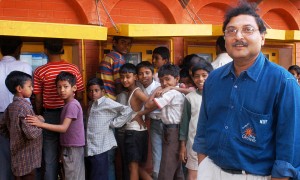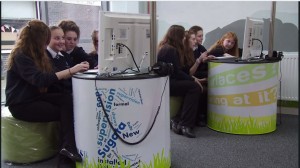From the Lecture Hall to a Hole in the Wall: Is the Future of Education Open Access?
While discussing the differences between “traditional” development and Open Access development, Eric Raymond creates the analogy of the cathedral and the bazaar. Traditional development, according to Raymond, mirrors cathedral building: it is carefully curated and designed, it is effectively a monument to the genius and vision of a particular viewpoint, and when it is finished, any alterations or additions run the risk of seeming like blasphemy or defacement. On the other hand, Open Access development is compared to a bazaar: it is a collaborative effort built up by a multitude of people; ever-evolving depending on the wishes of both vendors and buyers. Raymond strongly believes in bazaar-style development and the values it embodies: accessibility, collaboration, and joy.
Educational theorist and activist bell hooks wants education to be restructured as a liberatory practice, calling for educators to engage in “rupturing disciplinary boundaries, decentering authority.” (hooks 129) hooks’ view of “traditional pedagogy” is also cathedral-like: the university lecture hall is a place where a specific type of knowledge is held up and transmitted by a knowing professor to privileged and eager learners. With hooks’ liberatory pedagogical practices, however, the hallowed university lecture hall would be smashed open, allowing diverse ideas and voices to participate in and contribute to their own educational development. Like Raymond’s vision of open source development, hook’s liberatory pedagogy revolves around accessibility, collaboration, and joy.
It might seem impossible that a useful education could be provided for free, guided only through collaboration with volunteers and other learners, and motivated only by the joy of learning. It might also sound impossible for a “a world-class operating system” to “coalesce as if by magic out of part-time hacking by several thousand developers scattered all over the planet, connected only by the tenuous strands of the Internet” (Raymond Cathedral). And yet, through methods exactly like that, Open Access has already produced successful software. Could Open Access methodologies also help produce successful and liberatory education?
Sugata Mitra thinks so. He’s the computer-science and physics professor-turned-educational-reformer behind “Hole in the Wall Education Project”, “The School in the Cloud”, and “Self Organized Learning Environments (SOLE)”. Mitra rose to fame in Britain and India with his Hole in the Wall Education Project, which involved installing old computers from the IT Training facility he worked for in kiosks in remote and disadvantaged parts of India. He observed that children who were curious about the computers could teach themselves how to use them, and were able to use these computers to find answers to complicated questions. In 2013, he presented a TED Talk about his findings from this project, declaring that “schools as we know them are obsolete” (Mitra 2:55). Instead of traditional schools, he promotes learning through access to technology, collaboration with other users of technology, and incorporating joy and interest in learning. Mitra calls his current project “The School in the Cloud” which focuses on giving children access to information, but not “teaching” them anything. As Mitra says, his project “[is] not about making learning happen. It’s about letting it happen.” (School in the Cloud 1:14-1:18). The project focuses on allowing self-selected groups of learners to problem solve independently, and insists that access and encouragement are not just key pedagogical tools, but in fact, the only pedagogical tools necessary.
One of the main features that supporters of open access promote is accessibility. Peter Suber notes that open access supporters normally focus on only price and permission barriers, but would also support removing filtering and censorship barriers, language barriers, handicap access barriers, and connectivity barriers (Suber Overview). This attitude aligns with the aims of liberatory teaching practices, which aim to remove barriers and “deconstruct the way power has been traditionally orchestrated in the classroom, denying subjectivity to some groups and according it to others” (hooks 139). In order to remove the problem of inaccessible classrooms, Mitra’s School in the Cloud simply removes classrooms and teachers from schooling altogether. He believes that learning may happen anywhere, so learners are given only computer access, questions, and time, and they are free to guide their own learning. Mitra describes the freedom of choice that learners are presented with in his “Self-Organized Learning Environments (SOLE) as “anything but a classroom.” (Open Lab 00:43) Sometimes these SOLEs are in classrooms in schools, but Mitra insists that they could be anywhere – in a home, in a mall, in a community centre, or on a street corner, like his Hole In the Wall Learning Project computers.
But does all this freedom and access actually produce beneficial results? Mitra says that his program is that his program is “supporting children all over the world to tap into their wonder and their ability to work together,” but very little actual support is provided (Mitra 20:01-20:07). Instead of teachers in the classroom, the only learnng support is provided by volunteer “Grannies” from the UK who offer compliments and encouragements in English via Skype. Critics of open access systems think that the accessibility promised to disadvantaged groups is a mirage, and that “certain forms of open access policy may result in no less problematic forms of exclusion for the same groups” (Allington section 2). For example, David Allington argues that open access in publishing could mean that only those who already have support will continue to be supported. Open Access might mean that it is easier for popular and well-funded academics to get their work published more frequently, but it would make it harder for more unknown academics to even get noticed. In the same vein, critics noticed that Mitra’s “free and accessible for everyone” kiosks actually “worked best for the strongest boys on the streets” (Watters Hacking). Instead of making education accessible to all, the project made education a free-for-all, reachable only by those with enough power and strength.

[source likesuccess.com/author/sugata-mitra]
Similarly, Sebastien Thurn, the co-CEO of Massive Open Online Course (MOOC) provider Udacity also thinks open education practices are more exclusive than they seem. Although MOOCs initially seemed revolutionary, they have not lived up to the hype. MOOCs were often talked about as a way to support “under-served students”, but educators found that “the people that do well in these kind of courses are people who are already studious, …or are taking courses for their own enrichment after graduation” (Westervelt Online Education). Critiquing his own company’s products, Thurn said “online education that leaves almost everybody behind except for highly motivated students, to me, can’t be a viable path to education.” (NPR 3:19) In Thurn’s view, open access courses actually further disadvantage learners who are already struggling. Paradoxically, removing the walls of the classroom seems to build higher barriers for struggling learners, as they no longer have a clear space to go and ask for help, and no one to model how they could be learning.
Herein lies some of the most dangerous consequences behind “open access” and “open education” – that they only appear open and accessible, without actually being either. Those with funds, time, and support can access information more easily, and are able and encouraged to share their voices and knowledge – as critic Casey Brienza puts it, “those who get heard are those with the disproportionate means to make themselves heard” (Allington section 5). Those without means never get a chance, and worse, it appears to outsiders they have had their chance but simply missed it. A false meritocracy is created, and those who fail to succeed are further condemned for their failures in a rigged system.
Raymond is adamant that Open Source development requires enthusiastic and charismatic leaders, saying that “to make the bazaar model work, it helps enormously if you have at least a little skill at charming people” (Raymond Cathedral). The success of open access projects requires other people to do work for free, which in turn requires a Big Idea they can feel good about, and a leader who can convince them to rally behind it. Unfortunately, the Big Idea of accessibility that is promoted so loudly and so often by advocates like Sugata Mitra is merely an illusion.
I don’t mean to suggest that open access education programs are without merit, or that their charismatic promoters ultimately have ulterior motives. I am suggesting that barriers to education are too big of a problem to be clearly measured by those who have never had to overcome them, and that the loudest, most well-produced voices don’t necessarily have the most revolutionary ideas. To paraphrase David Allington, instead of empowering learners to “consume knowledge” given to them by “superstars”, accessibility should aim to increase the participation of these same scholars in producing knowledge themselves (section 5). Accessibility is an important goal, but open education must be careful to work towards a real accessibility that actually overcomes inequality, and not just something that sounds like it.
Works Cited
Allington, Daniel. “On Open Access, and Why It’s Not the Answer.” Daniel Allington.net. 15 October
2013.www.danielallington.net/2013/10/open-access-why-not-answer/. Accessed 21 Sep 2016.
hooks, bell. “Building a Teaching Community: A Dialogue”. Teaching to Transgress: Education as the Practice of Freedom. Routledge: 1994. pp 129-165.
Mitra, Sugata. “Build a School in the Cloud.” TED2013: The Young. The Wise. The Undiscovered. Long Beach, CA. February 2013. ww.ted.com/talks/sugata_mitra_build_a_school_in_the_cloud Accessed 27 Sept 2016.
Raymond, Eric Steven. “The Cathedral and the Bazaar.” CatB.org. Version 3.0. 2 Aug 2002. www.catb.org/~esr/writings/cathedral-bazaar/cathedral-bazaar/ Accessed 24 Sept 2016.
Suber, Peter. “Open Access Overview.” Earlham College. 21 June 2004,legacy.earlham.edu/~peters/fos/overview.htm. Accessed 22 Sept. 2016.
“The Online Education Revolution Drifts Off-Course.” Around the Nation. NPR. 31 Dec 2013.www.npr.org/templates/transcript/transcript.php?storyId=258420151 Accessed 28 Sept 2016.
Watters, Audrey. “Hacking at Education: TED, Technology Entrepreneurship, Uncollege, and the Hole in the Wall”. Hack Education. 3 Mar 2013. hackeducation.com/2013/03/03/hacking-your-educationstephens-hole-in-the-wall-mitra. Accessed Sept 29 2016.
Westervelt, Eric. “The Online Education Revolution Drifts Off Course”. All Things Considered. NPR. 31 Dec 2013. www.npr.org/2013/12/31/258420151/the-online-education-revolution-drifts-off-course
“What is School in the Cloud?” Open Lab, 2014. Vimeo. vimeo.com/88065448 Accessed 28 Sept 2016.


